Penrhyncoch is a small village, in the community of Trefeurig, located between the Afon Stewi and Nant Seilo rivers, about 4 1⁄2 miles north-east of Aberystwyth. The men of the area who fell during both World Wars are commemorated on slate tablets which are affixed to the base of a roughly hewn block of locally quarried quartz. A further brass plaque is located inside St John’s Church, which commemorates the men who served in the Great War, those who served and died, and those who returned. The church dedicated to St John the Divine was consecrated in 1881. The land and much of the cost of the building was given by Sir Pryse Pryse of Gogerddan. It was built by Mr Roderick Williams of Aberystwyth with stone from the quarry behind the Queens Hotel in Aberystwyth.
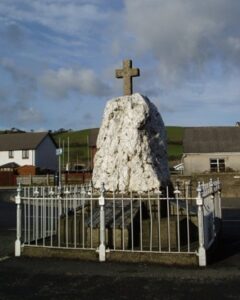
The Great War, 1914-1918
Hugh Davies, Private, 13002, Devonshire Regiment. Hugh was born at Penrhyncoch, the son of Jane Davies and resided at Fronsaint. His mother had been widowed prior to the war and lived at 7, Upper Brynhyfryd Terrace, Senghenydd. Hugh enlisted at Ferndale into the army, and landed in France on 27 July 1915, attached to the 9th (Service) Battalion, Devonshire Regiment, which was attached to the 20th (Light) Division. In August 1915 the battalion transferred to 20 Brigade, 7th Division, and took part in the Battle of Loos the following month. Hugh was killed in action at Loos, at some time between 25 and 30 September 1915. He has no known grave, and is commemorated on the Loos Memorial, France.
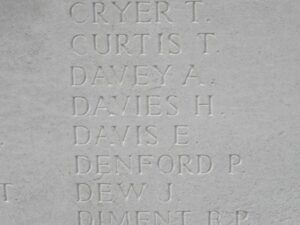
William John Davies, Private, 17280, South Wales Borderers. William was the son of James and Margaret Davies, of Cwmerfin Cottage, Cwmerfin, Bow Street. He married Margaret Richards in 1910 and the couple lived at Hyfrydle, Goginan. He enlisted at Newport, Monmouth into the 6th Battalion, South Wales Borderers, which was attached to the 25th Division, as the Divisional Pioneers. The Division landed in France on 26 September 1915, and was posted to the Vimy area, where it defended Vimy Ridge against a German attack in May 1916. It then moved to the Warloy area and attacked on 3 July near Thiepval, remaining on the Somme for the rest of the year. William was killed while working on roads near Blighty Valley, Authillle on 3 October 1916. He was thirty four years old, and is commemorated on the Thiepval Memorial, France.
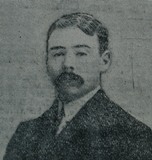
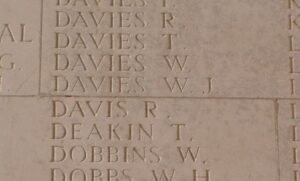
Percy Gunn, Private, 17959, South Wales Borderers. Percy was from Braintree, Essex. He had moved to west Wales to work as a farm hand prior to the war, and worked at Frondeg Farm, Penrhyncoch. Percy was living at Gogerddan Place, Llangorwen prior to the war and enlisted at Aberystwyth into the 5th Battalion, South Wales Borderers. The battalion landed in France during July 1915 attached to 58 Brigade, 19th (Western) Division. The division had a reputation for fierce fighters, and had fought at the Battle of Loos in 1915, and throughout the Somme offensive the following year. During 1917 it had taken part in the Battle of Messines, and the following Third Battle of Ypres, before being moved south to positions facing the Hindenburg Line near Bapaume. The division was hit by the German spring offensive, which was launched on the Somme on 21 March 1918, and saw heavy fighting over the coming days. Percy was killed in action during the ensuing fighting, on 23 March 1918, aged 21. He has no known grave, and is commemorated on the Arras Memorial, France. Percy does not appear to be commemorated locally.
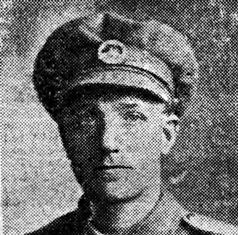
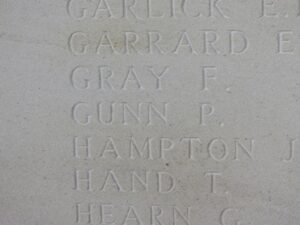
James James, Lance Corporal, 22127, Welsh Regiment. James was born in 1893, the son of Thomas and Sarah James of Llanbadarn. He enlisted at Tonypandy into the 15th Battalion, Welsh Regiment, which was known as the Carmarthen Pals battalion, attached to 114 Brigade, 38th (Welsh) Division. On 2 December 1915 the battalion moved to France, and the entire Division moved to the Fleurbaix sector, where it was initiated into trench warfare. During June 1916 the Division marched south to the Somme, and on 7 July 1916 attacked Mametz Wood. The initial attack failed, and it was three days later, on 10 July, that a fresh attack was mounted. James was killed in Mametz Wood on 11 July 1916. He was 23 years old, and is commemorated on the Thiepval Memorial, France. There is also a memorial to James at Capel Bethel, Cwmerfyn.
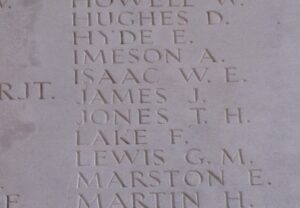
William James, Pioneer, 159319, Royal Engineers. William was the son of David and Mary James, of 17, Pencae, Taliesin. He originally enlisted at Aberystwyth into the South Wales Borderers, but was transferred to the 5th Battalion Special Brigade, Royal Engineers, which was a Special (Gas) Company. The Battalion was a Stokes mortar unit, attached to the Fourth Army. The Battalion was on the Somme in the summer of 1916, where it was to provide support for the forthcoming Battle of the Somme. William was killed during the build up to the battle, probably whilst moving equipment into place. He was 22 years old, and is buried at Hébuterne Military Cemetery, France.

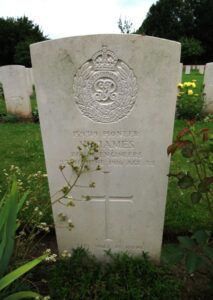
William John James, Gunner, 118023, Royal Field Artillery. William was born in 1894, the son of Evan and Mary James, of Broncastellan, Penrhyncoch. He enlisted at Newport on 23 March 1916 into the Royal Artillery, and was posted to the 9th Reserve Battery, Royal Field Artillery. On 30 March 1917 William was discharged from the RFA as medically unfit, after having been found to have suffered badly during his training at Preston. He died on 23 April 1917, aged 23, and is buried at Penygarn Calvinistic Methodist Cemetery, Tirymynach.
Daniel Evan Jones, MM, Private, 3015, Welsh Guards. Daniel was born in 1891, the son of Richard and Margaret E. Jones, Glanyrafon, Llanbadarn Fawr. He enlisted at Aberystwyth into the 1st Battalion, Welsh Guards, which had been raised by Royal Warrant of 26 February 1915, at White City. On 18 August 1915 the Welsh Guards landed at Havre, joining the 3rd Guards Brigade, Guards Division, and saw their first action at the Battle of Loos. Daniel didn’t join the battalion until sometime after the Somme Battles of 1916. He would have fought at the Battle of Pilckem Ridge in August 1917, and at the Battle of Cambrai later that year. The Guards had a hard time at Gouzeaucourt over the winter of 1917-18, but after the launching of the great offensive on 21 August 1918, the Guards took part in the drive towards the Hindenburg Line. Once the Hindenburg Line had been broken, the Allies swept eastwards, and the Guards fought at the Battle of Cambrai, and the Battle of the Selle and the Sambre. Daniel was badly wounded during the fighting around Cambrai, and was evacuated for treatment. He died of his wounds on 14 October 1918, aged 27, and is buried at Delsaux Farm Cemetery, Beugny, France.
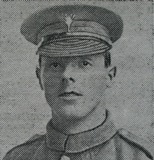
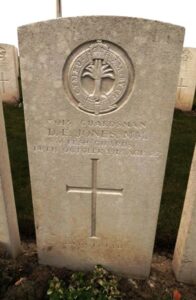
David Edward Jones, Private, 187612, Canadian Infantry. David was born on 10 January 1886, the son of Jenkin and Esther Jones, of Tynpynfarch, Penrhyncoch. He emigrated to Canada prior to the war, and enlisted on 20 October 1915 at Winnipeg into the Canadian Infantry. David was posted to England, and then onto France joining the 27th Battalion, Canadian Infantry (City of Winnipeg), which was attached to 6th Brigade, 2nd Canadian Division. David would have fought throughout the Somme Offensive with the battalion, at Flers-Courcelette, Thiepval Ridge, Le Transloy and the Battle of the Ancre. After the Somme offensive was closed down, the Canadians moved to Arras, taking part in the famous capture of Vimy Ridge on 9 April 1917. David was killed at Arras during the Third Battle of the Scarpe, on 3 May 1917. He was 31 years old, and is commemorated on the Vimy Memorial, France.
Richard Lewis, Private, 22632, Welsh Regiment. Richard was born at Tyncwm, Penrhyncoch. He enlisted at Porth, Glamorgan into the 10th Battalion, Welsh Regiment (1st Rhondda), which trained at Rhyl, before moving to Winchester, attached to 114 Brigade, 38th (Welsh) Division. On 2 December 1915 the battalion moved to France, and the entire Division moved to the Fleurbaix sector, where it was initiated into trench warfare. During June 1916 the Division marched south to the Somme, and on 7 July 1916 attacked Mametz Wood. The initial attack failed, and it was three days later, on 10 July, that a fresh attack was mounted. Richard was killed in action just before the division was relieved, on 12 July 1916. He has no known grave, and is commemorated on the Thiepval Memorial, France.
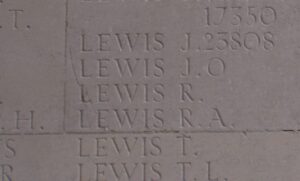
Robert Lewis, Private, 88489, King’s Liverpool Regiment. Robert was born at Llanbadarn in 1880, and was the Husband of Ethel M. Lewis. He originally enlisted at Aberystwyth into the East Surrey Regiment, but was later transferred into the 6th Battalion, King’s Liverpool Regiment, which was attached to 165 Brigade, 55th (West Lancashire) Division. The Division was formed in France during January 1916, and moved to Arras. During July 1916 the Division moved south and took up a place in the front line opposite the village of Guillemont, fighting at the Battle of Guillemont and the Battle of Ginchy. After a brief rest, the Division fought at the Battle of Flers-Courcelette and the Battle of Morval. During October 1916 the Division moved to Ypres, taking over the Railway Wood sector, and on 31 July 1917 took part in the Battle of Pilckem. After suffering terrible casualties, the Division was withdrawn to Recques for re-fit and training, before moving back into the line on 15 September, and fighting at the Battle of the Menin Road. Robert was killed in action here on 29 October 1917. He was 37 years old, and is commemorated on the Tyne Cot Memorial, Belgium.
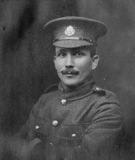
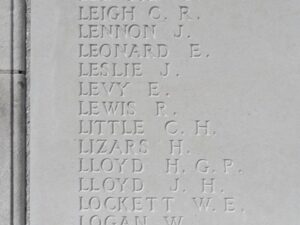
John David Messer, Private, 15439, Essex Regiment. John was born at Penbontrhydybeddau in about 1892, the son of David and Louisa Gray Messer. By 1902 the family had moved to London, where David ran his own dairy business. John was educated there before becoming a merchant in the city prior to the war. He enlisted into the Essex Regiment at Stratford soon after war was declared and was posted to France with the 9th Battalion, Essex Regiment on 30 May 1915. The battalion was attached to 12th Division and took over the line at Ploegsteert Wood before being moved to take part in the Battle of Loos, and the subsequent actions of the Hohenzollern Redoubt. By June 1916 the division was in position at the Somme, and attacked Ovillers on 2 July. During the following year the division took part in the Battle of Arras, and remained in the area before taking part in the Battle of Cambrai in November 1917. It was relieved at the beginning of December, and moved to positions near Albert to rest, before relieving the 38th (Welsh) Division in the Fleurbaix front line in February 1918. A month later the division moved south again and was caught up in the German offensive, Operation Michael. John was wounded at some time during the desperate fighting which followed and was evacuated to the 18th General Hospital at Étaples, where he died of his wounds on 13 April 1918, aged 26. He is buried in Étaples Military Cemetery. France. As far as is known, John does not appear on any local war memorial. Many thanks to Will Troughton for the photograph of John and for informing me of his local ties.
Benjamin Arthur Morris, Private, 57051, Welsh Regiment. Benjamin was the son of Lewis and Mary Morris, of Trefeurig, Bow Street, Cardiganshire, and the husband of Margaret J. Morris, of Fair View, Salisbury Road, Maesteg. He enlisted at Bridgend into the Glamorgan Yeomanry, and was posted to France, probably late in 1916, joining the 14th Battalion, Welsh Regiment, which was attached to 114 Brigade, 38th (Welsh) Division. The division had moved to Ypres after its exertions at Mametz Wood, to rebuild in the quieter sector along the Boesinghe Canal. It was from here, on 31 July 1917 that the division made its famous assault which captured the Pilckem Ridge, and after seeing further action at Langemarck moved to the Fleurbaix sector to rebuild again. In April 1918 the division was moved to the Somme to counter the German offensive there, and spent several months in the line north of Albert, prior to launching its famous attack across the River Ancre on 21 August 1918. The division then began its drive across the old Somme battlefields, and by the end of August had reached Morval, a strongly defended village. Benjamin was killed during the attack on the village on 1 September 1918. He was 28 years old, and is buried in Morval British Cemetery, France.
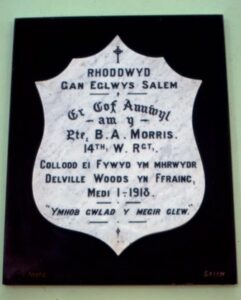
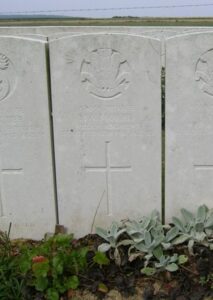
William Penwill, Private, 25865, Devonshire Regiment. William was born at Torquay on 27 June 1885, the son of William and Maria Penwill, of Liswomey, of Lower Lincombe Road, Torquay. He was residing at Gogerddan prior to 1911, where he worked as a Gardener for Sir Edward John Webley Parry Pryse. William married Ellen Louisa Manning on 9 March 1912, and the couple resided at Edge Mill Road, Aberystwyth, with their daughter Marjorie. William enlisted at Aberystwyth into the army, and was posted to the 9th (Service) Battalion, Devonshire Regiment, which was attached to 20 Brigade, 7th Division. In the summer of 1916, the Division was on the Somme, and took part in the Battle of Albert, where they captured Mametz. The Division then fought at the Battle of Bazentin, and the Attacks on High Wood, and took part in the later Battle of Delville Wood, and the Battle of Guillemont, before spending the winter on the Ancre. In March 1917 the Division followed up the German Retreat to the Hindenburg Line, and took part in Flanking Operations Round Bullecourt, where it saw heavy fighting alongside the Australians. William was wounded at Bullecourt, and died of his wounds near Bapaume on 7 May 1917. He was 31 years old, and is buried at Grevillers British Cemetery, France.
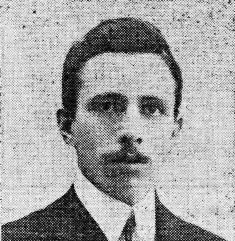
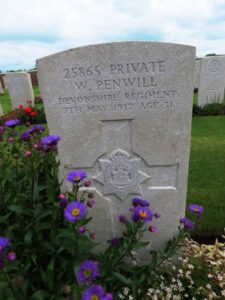
Sir Edward John Webley Parry Pryse (Bart), Major, Welsh Regiment. Edward was born in 1862 at Llanbadarn, the son of Sir Pryor Pryse, of Gogerddan. Edward married Nina Katherina Angharad Webley-Parry, daughter of David Kedgwin William Henry Webley-Parry and Nina Katherina Elena de Palatiano, in 1891. Edward had served in the army for some years prior to the outbreak of the Great War, and volunteered to serve with the 9th Battalion, Welsh Regiment, which was attached to 58 Brigade, 19th (Western) Division. The Division moved to France during July 1915, and moved to positions near Loos, where it took part in the opening attack of the Battle of Loos on 25 September 1915. The following year the Division moved to the Somme, where it took part in the second wave of the attack on Ovillers-La Boiselle on 1 July, capturing the village at heavy cost. It then fought through the Somme Battles of Poziéres and the Ancre in 1916. In 1917 the Division moved north to Ypres, taking part in the Battle of Messines, then the Third Battle of Ypres. In 1918 the Division had a terrible time, being caught up in the three main German attacks that year, on the Somme, on the Lys and on the Aisne. By then, Edward had been invalided home. He died on 20 October 1918, aged 56, and is buried at Penrhyncoch, at Eglwys Sant Ioan. Edward is not commemorated by the CWGC.
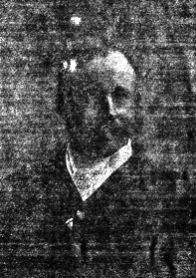
Thomas Henry Thomas, Corporal, 54257, Royal Welsh Fusiliers. Thomas was born in Penrhyncoch in 1896, the son of David and Margaret Thomas. The family later resided at 22, Lake Street, Ferndale, and Thomas enlisted at Porth into the Welsh Regiment. He was transferred to the 14th Battalion, Royal Welsh Fusiliers, which was in France attached to 113 Brigade, 38th (Welsh) Division. The division had moved from the Somme to positions north of Ypres, along the Boesinghe Canal at the end of 1916, after having suffered heavy casualties at Mametz Wood. It took part in the Battle of Pilckem Ridge on 31 July 1917, and wintered in the Armentieres sector before moving to the Somme at the end of March 1918. Thomas was wounded near Aveluy Wood, and died on 21 June 1918, aged 21. He is buried in Varennes Military Cemetery, France. He does not appear to be commemorated locally.
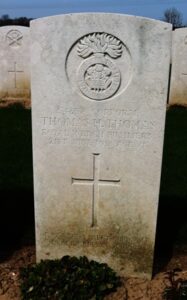
Trevor Williams, 41754, Colour Serjeant, Welsh Regiment. Trevor (Trefor) was born on 23 May 1896 and was raised by his aunt, Edith Williams, at Garth, Penrhyncoch. Very little information about him can be traced, but he died at Aberystwyth on 18 September 1920, aged 24, and is buried in Horeb Baptist Chapelyard, Penrhyncoch.
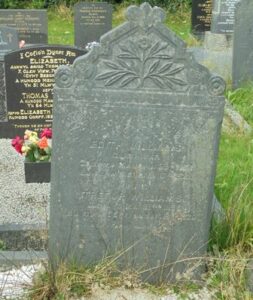
World War Two, 1939-1945
Ceredig Davies, Rifleman, 6850238, King’s Royal Rifle Corps. Ceredig was the son of Llewellyn and Bronwen Davies, of Cwmsymlog, Penrhyncoch. He served with the 12th (2nd Bn. The Queen’s Westminsters) Battalion, King’s Royal Rifle Corps. The battalion had fought in North Africa, as part of the 8th Armoured Brigade, returning to Britain in December 1943 after the surrender of the Afrika Corps. It took part in the Normandy landings in June 1944, and in the subsequent break-out from the Normandy beaches, and the drive through France into Belgium and Holland. Ceredig was killed just after the end of Operation Market Garden, on 9 October 1944. He was 29 years old, and is buried at Jonkerbos War Cemetery, Netherlands.
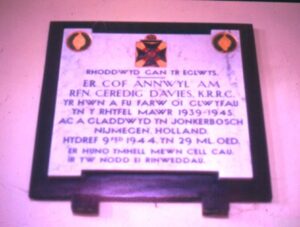
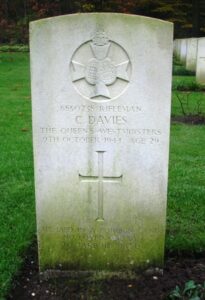
Myrddin Jones, Sergeant, 1602070, Royal Air Force Volunteer Reserve. Myrddin was the son of John and Mary Jones, of Salem, Bow Street. He served as an Air Gunner with 619 Squadron, Royal Air Force, which was a heavy bomber squadron, based in Lincolnshire, equipped with the Avro Lancaster. At about 17.20 on 20 October 1943 Myrddin took off from RAF Woodhall Spa aboard Lancaster III, Serial EE114, under the command of Pilot Officer Christopher Firth, which was the first large scale bombing raid of the war, with some 385 Lancaster’s despatched to bomb Leipzig. Myrddin’s Lancaster was among 16 lost on the raid, crashing vertically into the ground near Langwedel, killing all seven men aboard. Myrddin was just 21 years old when he was killed during the crash. He was initially buried alongside his fellow crewmen in Langwedel, but after the war their graves were relocated into Hanover War Cemetery, Germany.
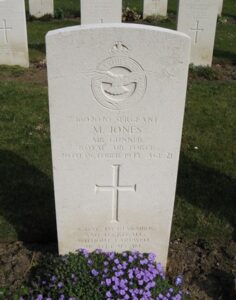
Heaton Lumley, Major, Royal Marines. Heaton was born at Haulbowline, Cork, Ireland on 18 January 1900, the son of Frederick and Martha Lumley, and had been educated in England before being commissioned into the Royal Marines. He married Olwen Esther Joan Pryse, the daughter of Herbert William Pryse and Elizabeth Schuler Pryse, of Gogerddan. Heaton was serving aboard the famous Battlecruiser HMS Hood by the outbreak of the war. Hood took part in the famous hunt for the German Battleship Bismarck, and on 24 May 1941 Hood and Prince of Wales spotted Bismarck in the North Sea. Hood was struck by several shells from Bismarck, one of which hit one of her aft magazines, resulting in a colossal explosion which blew Hood apart. Only three men from her crew of 1,418 men survived. Heaton was 41 years old when he died that day, and is commemorated on the Portsmouth Naval Memorial, Hampshire. Heaton is not commemorated on the Penrhyncoch memorial, although his wife Olwen, who died on 28 June 1940, is buried there.
Penrhyncoch (St John’s Church) Memorial, The Great War, 1914-1918
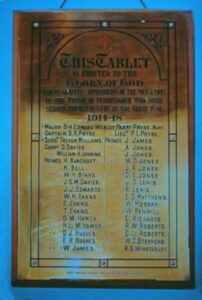
In memory of the men and boys of the
parish of Penrhyncoch who nobly served their country
in the Great War 1914-18
+Major Sir Edward Webley PARRY-PRYSE, Bart.
Captain G. R. PRYSE Lieut. P. L. PRYSE
+Sergt. Trevor WILLIAMS Private J. JAMES
Corpl. D. DAVIES Private A. JONES
Corpl. William H. JENKINS Private J. JONES
Private H. BANCROFT Private W. D. JONES
Private K. BELL Private J. R. JONES
Private W. H. BINKS + Private D. E. JONES
Private J. G. M. DAVIES Private J. D. LEWIS
Private J. J. EDWARDS + Private R. LEWIS
Private W. H. EVANS Private E. O. MATTHEWS
Private E. EVANS Private W. MORGAN
Private T. EVANS + Private W. PENWILL
Private D. M. HAMER Private E. RICHARDS
Private H. Ll. M. HAMER Private R. W. ROBERTS
Private D. J. HUGHES Private C. Ll. ROBERTS
Private E. R. HUGHES Private W. C. STEPHENS
+ Private W. JAMES Private R. S. WINSTANLEY
Those marked + gave their lives for their country